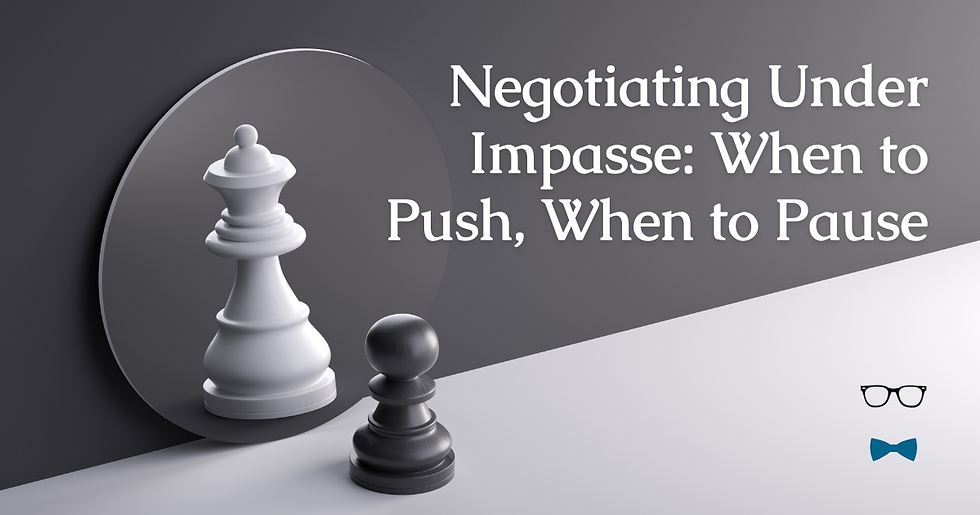More Than Money: The Power of Non-Monetary Relief in Mediation
- Cooper Shattuck

- Jul 7
- 3 min read
When people think about legal disputes, they often think in terms of dollars—how much one party will pay and how much the other will receive. And while financial compensation is a common form of relief, it’s far from the only tool available to parties looking to resolve a conflict, especially in mediation.

One of the greatest advantages of mediation is the opportunity to craft resolutions that courts simply cannot order. Mediation is not constrained by statutory remedies or limited to binary “win/lose” outcomes. It invites creativity. And often, the most satisfying, durable, and cost-effective solutions are those that go beyond the money.
Here are four examples of how non-monetary relief can change the game in different types of cases, including environmental, construction, bankruptcy, and complex litigation.
1. Environmental Dispute: Land Use, Not Just Lawsuits
In a dispute between a manufacturing company and a local conservation group, the group sued over potential contamination of a nearby waterway. A court could have ordered fines or mandated cleanup. But through mediation, the parties reached a more forward-thinking solution.
The company agreed to create a permanent conservation easement on adjacent undeveloped land, install real-time environmental monitoring systems accessible to the public, and fund a local education initiative on watershed preservation. These commitments not only addressed the group’s concerns but also enhanced the company’s public image and reduced the risk of future litigation.
This is the kind of win-win resolution that no judge could have imposed, but that only mediation could deliver.
2. Surety and Construction Case: Preserving Relationships and Reputations
In a multi-party dispute over delays and defects in a hospital construction project, the owner, general contractor, subcontractors, and surety were entrenched in blame and counterclaims. Rather than litigating for years, they turned to mediation.
Through creative negotiations, the parties agreed to a phased completion plan supervised by a neutral project monitor, along with a joint public statement affirming continued collaboration. The surety contributed funds toward specific remedial work in lieu of a blanket payout, preserving relationships and reducing reputational damage for all parties involved.
A court could have assigned liability and ordered damages, but it could not have salvaged working relationships or protected professional reputations.
3. Bankruptcy Chapter 11 Case: Crafting a Confirmable Plan
A struggling regional chain in Chapter 11 faced objections to its reorganization plan from key creditors. Mediation enabled the parties to explore alternatives that met both the debtor’s need for operational breathing room and the creditors’ desire for long-term value.
Instead of simply restructuring payments, the mediated agreement included a plan for converting some debt to equity, adding an independent board member acceptable to creditors, and granting enhanced financial reporting rights. The result? A confirmable plan that avoided prolonged confirmation hearings, preserved jobs, and gave creditors a path to potential recovery through future growth.
This is a powerful example of how mediation allows stakeholders to shape a workable future beyond the binary up-or-down confirmation ruling of a bankruptcy court.
4. Complex Litigation: Beyond the Verdict
In a sprawling multidistrict litigation involving defective components used in public infrastructure, dozens of government entities and private manufacturers were locked in discovery battles. Mediation presented a way out.
The ultimate resolution included not just financial settlements, but also commitments to redesign future products, provide training to public works departments on risk mitigation, and create a national registry for defect reporting.
No court could have crafted such a comprehensive, forward-looking outcome. But mediation allowed the parties to think bigger and smarter.
The Takeaway: Why Non-Monetary Relief in Mediation Matters
Mediation offers the rare opportunity to break free from the rigid structures of litigation and design customized solutions that actually solve problems, often in ways a court never could.
Non-monetary relief in mediation isn’t just an add-on; it’s often the key to unlocking resolution. Whether it's preserving relationships, protecting reputations, creating transparency, or setting the stage for long-term success, thinking beyond the dollar signs can make all the difference.






Comments